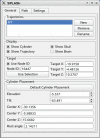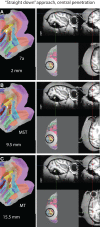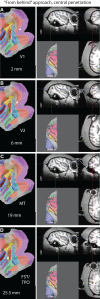Splash: a software tool for stereotactic planning of recording chamber placement and electrode trajectories
- PMID: 21472085
- PMCID: PMC3065657
- DOI: 10.3389/fninf.2011.00001
Splash: a software tool for stereotactic planning of recording chamber placement and electrode trajectories
Abstract
While computer-aided planning of human neurosurgeries is becoming more and more common, animal researchers still largely rely on paper atlases for planning their approach before implanting recording chambers to perform invasive recordings of neural activity, which makes this planning process tedious and error-prone. Here we present SPLASh (Stereotactic PLAnning Software), an interactive software tool for the stereotactic planning of recording chamber placement and electrode trajectories. SPLASh has been developed for monkey cortical recordings and relies on a combination of structural MRIs and electronic brain atlases. Since SPLASh is based on the neuroanatomy software Caret, it should also be possible to use it for other parts of the brain or other species for which Caret atlases are available. The tool allows the user to interactively evaluate different possible placements of recording chambers and to simulate electrode trajectories.
Keywords: electrode trajectories; monkey; recording chamber; software; stereotactic coordinates.
Figures













Similar articles
-
MR-guided stereotactic navigation.J Neurosci Methods. 2012 Mar 15;204(2):389-97. doi: 10.1016/j.jneumeth.2011.11.031. Epub 2011 Dec 13. J Neurosci Methods. 2012. PMID: 22192950 Free PMC article.
-
Cicerone: stereotactic neurophysiological recording and deep brain stimulation electrode placement software system.Acta Neurochir Suppl. 2007;97(Pt 2):561-7. doi: 10.1007/978-3-211-33081-4_65. Acta Neurochir Suppl. 2007. PMID: 17691348 Review.
-
Stereotactic neurosurgical planning, recording, and visualization for deep brain stimulation in non-human primates.J Neurosci Methods. 2007 May 15;162(1-2):32-41. doi: 10.1016/j.jneumeth.2006.12.007. Epub 2006 Dec 21. J Neurosci Methods. 2007. PMID: 17275094 Free PMC article.
-
Tactics: an open-source platform for planning, simulating and validating stereotactic surgery.Comput Assist Surg (Abingdon). 2020 Dec;25(1):1-14. doi: 10.1080/24699322.2020.1760354. Comput Assist Surg (Abingdon). 2020. PMID: 32401082
-
Automated neurosurgical stereotactic planning for intraoperative use: a comprehensive review of the literature and perspectives.Neurosurg Rev. 2021 Apr;44(2):867-888. doi: 10.1007/s10143-020-01315-1. Epub 2020 May 20. Neurosurg Rev. 2021. PMID: 32430559
Cited by
-
Improved methods for acrylic-free implants in nonhuman primates for neuroscience research.J Neurophysiol. 2017 Dec 1;118(6):3252-3270. doi: 10.1152/jn.00191.2017. Epub 2017 Aug 30. J Neurophysiol. 2017. PMID: 28855286 Free PMC article.
-
Seven Tesla Evidence for Columnar and Rostral-Caudal Organization of the Human Periaqueductal Gray Response in the Absence of Threat: A Working Memory Study.J Neurosci. 2024 Jun 26;44(26):e1757232024. doi: 10.1523/JNEUROSCI.1757-23.2024. J Neurosci. 2024. PMID: 38664013 Free PMC article.
-
A multimodal imaging-guided software for access to primate brains.Heliyon. 2023 Jan 4;9(1):e12675. doi: 10.1016/j.heliyon.2022.e12675. eCollection 2023 Jan. Heliyon. 2023. PMID: 36685404 Free PMC article.
-
Combining brain perturbation and neuroimaging in non-human primates.Neuroimage. 2021 Jul 15;235:118017. doi: 10.1016/j.neuroimage.2021.118017. Epub 2021 Mar 29. Neuroimage. 2021. PMID: 33794355 Free PMC article. Review.
-
MR-guided stereotactic navigation.J Neurosci Methods. 2012 Mar 15;204(2):389-97. doi: 10.1016/j.jneumeth.2011.11.031. Epub 2011 Dec 13. J Neurosci Methods. 2012. PMID: 22192950 Free PMC article.
References
-
- Baker J., Vytlacil J., Reid E., Van Essen D. (2008). Using Caret to guide single unit physiology. Available at: http://sumsdb.wustl.edu/sums/directory.do?id=6526890&dir_name=MAP_RECORD...
-
- Cox R. W. (1996). AFNI: software for analysis and visualization of functional magnetic resonance neuroimages. Comput. Biomed. Res. 29, 162–173 - PubMed
-
- Lewis J. W., Van Essen D. C. (2000). Mapping of architectonic subdivisions in the macaque monkey, with emphasis on parieto-occipital cortex. J. Comp. Neurol. 428, 79–111 - PubMed

